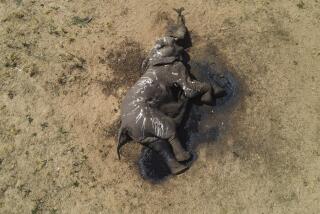Earthwatch: A Diary of the Planet
- Share via
African Wildlife Rescue *
Rising waters on Zimbabwe’s Lake Kariba have trapped thousands of animals that are now being fed by a massive relief effort launched by conservationists and farmers in the southern African nation. The animals are facing starvation on islands that are shrinking as the lake fills with water from the region’s unusually wet rainy season. The high water levels have forced the wildlife back from shoreline grazing into the treeline where there is no food. A series of droughts in the 1980s caused the lake’s water levels to drop dramatically and enabled the animals to cross easily from the mainland to areas that were formerly islands. Farmers have donated more than 100 tons of food and transported it on their own trucks to the city of Kariba. Volunteers are ferrying the supplies to the stranded animals, mostly impalas, hippos, baboons and waterbucks.
*
Sinking Islands
A group of islands in New Guinea is sinking into the Pacific at the rate of 4 to 6 inches a year, and a team of government scientists has recommended that their 20,000 residents be quickly relocated to a larger island. The Duke of York Islands are sinking not because of rising sea levels, but because of seismic activity. In 1994, two volcanoes on opposite sides of one of the islands erupted for four months. When the activity ceased, evacuees moved back, but the regional news service Pacnews now reports that further subsidence is forcing officials to move the inhabitants to the Gazelle Peninsula on New Britain. Many buildings on the islands are already under water.
*
Indian Ocean Drought
The island republic of Mauritius is in the throes of its worst drought in 95 years, forcing authorities to limit water use in the capital city of Port Louis to no more than six hours a day. The other 1.2 million residents of the Indian Ocean island will receive water for one hour a day.
*
Eruptions
Ecuadoran armed forces were called in to enforce evacuations of communities situated near two of the country’s most active volcanoes. Evacuations from around Guagua Pichincha Volcano, six miles from the capital city of Quito, were ordered because of the continuing increase in seismic activity. The military was under instruction to use force if necessary to keep residents from returning to their homes. The volcano triggered more than 2,000 tremors and 20 minor explosions of rock and ash during a single day.
Police used tear gas to hold back hundreds of residents who tried to return to their homes in the resort area of Banos in the evacuated zone around Tungurahua Volcano 75 miles south of Quito. More than 25,000 residents were evacuated from the area Oct. 16. Authorities said that an eruption of Tungurahua could engulf the entire city within 10 minutes. A series of small explosions has spewed out incandescent rocks three to five times every day.us
More to Read
Sign up for Essential California
The most important California stories and recommendations in your inbox every morning.
You may occasionally receive promotional content from the Los Angeles Times.













